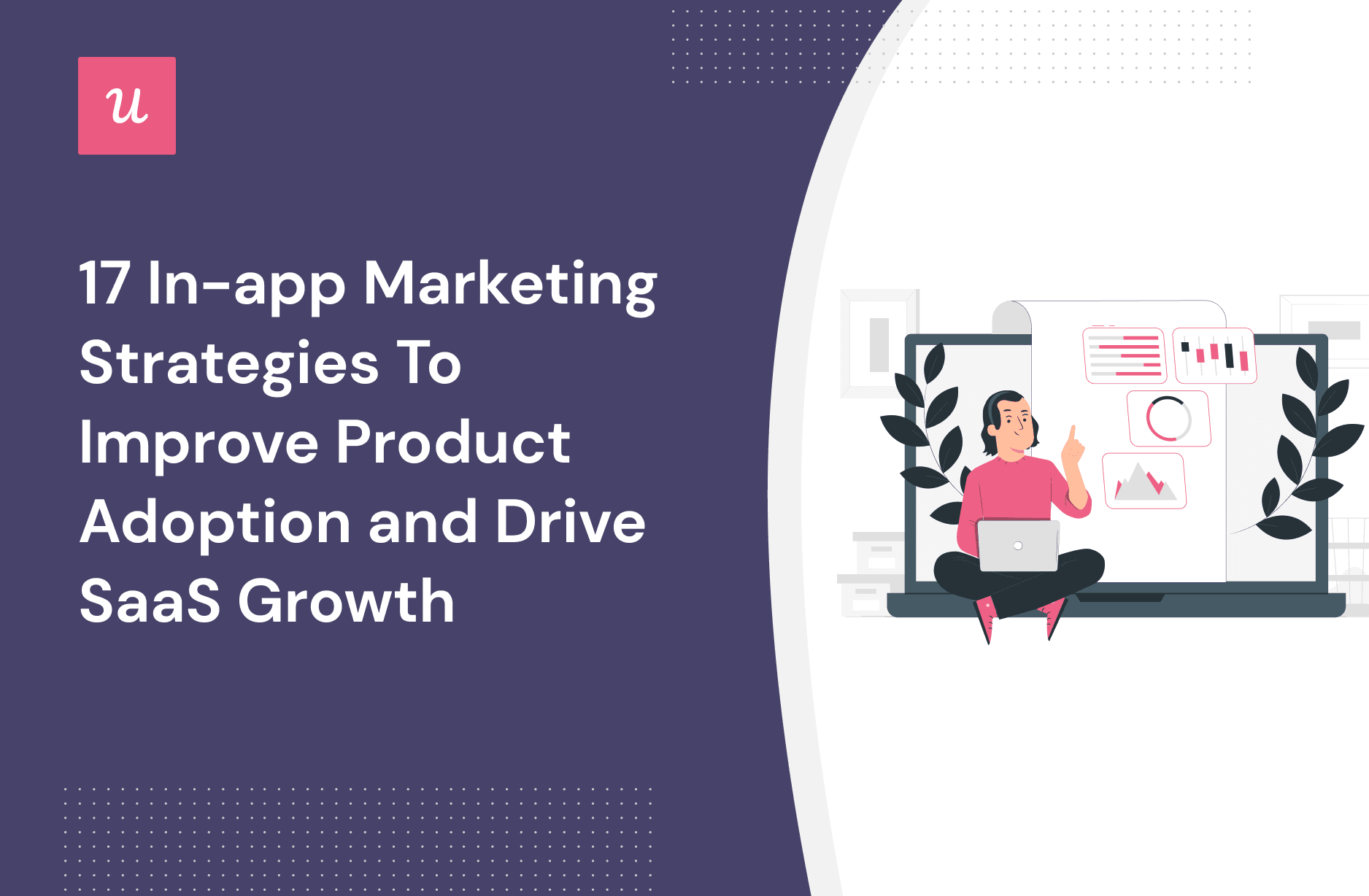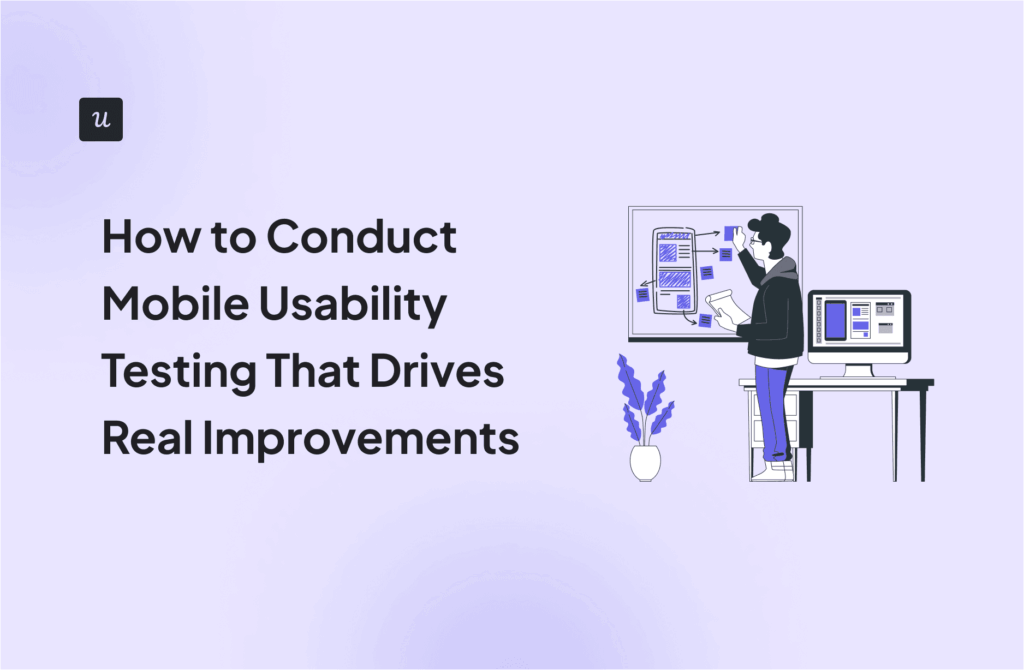
17 In-app Marketing Strategies To Improve Product Adoption and Drive SaaS Growth
Get The Insights!
The fastest way to learn about Product Growth, Management & Trends.
What is in-app marketing?
In-app marketing, aka in-product marketing, is any message or marketing campaign displayed inside the app and designed to make users take specific action steps.
In-app messages are usually triggered by user actions, therefore tailored to specific user segments and their journey stages.
Why do you need an in-app marketing strategy?
An in-app marketing strategy gives you structure. It ensures you don’t trigger messages anyhow and annoy users.
A strategy also means you can stay accountable by regularly tracking your results and finding improvement areas.
How in-app marketing benefits users:
- Unlock your product’s total value: The thing about B2B users is they rarely have time to explore your product and adopt all its features on their own. But by triggering contextual in-app guidance, you’ll point them in the right direction and help them maximize your tool.
- Remove friction and improve the customer experience: Paired with user behavior analytics, in-app marketing helps address friction points in the user journey. Customers will progress more smoothly and be generally happy with their product experience.
- Retain, and upsell customers: Users will be motivated to stick around when they clearly see the value your tool brings. And it works like a loop: the more they engage and see the ROI, the stickier they’ll become. Such customers are also the most likely to upgrade to higher product versions.
How is in-app marketing different from mobile-app marketing?
They achieve the same objective, but there are a few nuances due to platform differences.
For example, mobile marketing needs to be fast and not take up much space because of the mobile environment. Even your push notifications can’t have many details or users will consider it spamming. However, you can be more elaborate when your messages target web users.
Another difference is in the funnels.
Both funnels begin with awareness, but the app funnel moves right into acquisition and conversion, while the web funnel takes it more slowly, nurturing the visitor toward retention.
17 Best in-app marketing strategies to drive SaaS business growth
Now that you’ve seen the importance of product marketing, let’s consider some in-app marketing strategies to help you do it effectively.
Optimize your landing page to drive user acquisition
Before you can even begin any in-app communication, you need to make sure users get inside the app. Do that by ensuring your landing page is designed to hook and convert visitors.
Social proof is the ultimate user magnet, so enrich your landing page with star ratings, client testimonials, and case studies. People will be more likely to sign up for a free trial if they see others like them are having success with the app.

In addition to social proof, prioritize benefits over features when writing your copy. Visitors don’t care what features you’ve built or how many months of code went into it; they just want to know if your platform can solve their problems.
Personalize user journey for different user personas
Personalization improves the customer experience and increases conversion. It’s effective because you’re addressing user needs rather than creating generic flows they won’t find helpful for their specific pain points.
Begin by collecting data with welcome screens to understand user JTBDs.
After that, use the information you gather to trigger tailored product experiences, showcasing only relevant features and guides.

Drive key feature discovery and adoption with checklists
Checklists are great when you need to prompt action and encourage users to explore features that bring them value.
Keep your checklists simple and tailored to the customer journey. You can add gamification elements like badges, levels, scorecards, or progress bars to drive high completion rates.

Replace long product tours with interactive walkthroughs
Linear product tours that are forced upon all new sign-ups are boring and ineffective. All they do is dump info on users without actually engaging them and helping them gain value from features.
On the other hand, contextual interactive walkthroughs help users actively learn by engaging features in real-time, thus shortening the activation path and leading to higher conversion rates.

Increase daily active users of key features with in-app guidance
Provide timely in-app guidance using a combination of UI patterns to remove friction and increase daily engagement.
For example, Grammarly uses hotspots to draw user attention to core features, and a tooltip is triggered when the user clicks on those features.
This kind of detailed guidance helps users know what to do to get repeated value.

Implement growth loops to drive potential users to your app
A growth loop is an in-app marketing strategy that ensures every user input leads to a new output, motivating them to keep taking action.
Loops come in different types, but they all have three main parts—input, action, and output.
Examples of SaaS growth loops include social shares, user-generated content, referral programs, etc.
To see how powerful growth loops work, consider this referral program by Evernote. The first three referrals give users points to subscribe for three months of premium access. And users get five more points each time their referrals subscribe to premium.
That’s enough motivation to make someone want to keep referring the people in their network.

Gamify the user experience to boost engagement
Celebrating small wins increases the chance of higher engagement as the user is motivated by success to repeat the actions that drove the previous win.
You can use celebration modals, fun animations, badges, etc., to gamify the customer experience. But, of course, consider your audience and the nature of your product to determine what will work best for them.
For example, Asana uses celebration modals when users hit important milestones in their journey.

Promote new features in-app using modals
Feature blindness is real – filtering information and sticking to our habits is deeply rooted in human psychology.
This kills feature adoption and shrinks your product adoption depth and breadth.
You can fight feature blindness and improve adoption rates by announcing new features in-app.
Modals work great for this. They are big enough to contain tons of useful info and since they cover the whole screen, users won’t miss them.
Ensure your copy on modals is easy to understand and highlights the new feature’s benefits. Also, add a clear CTA to drive immediate action.

Nudge existing users to upgrade to higher plans with contextual tooltips
Account upgrades benefit both you and the customer.
On the company’s part, it means higher customer lifetime value. For users, upgrades generally mean they can solve more problems and achieve their business objectives faster.
It’s important when you prompt an upgrade. The best times are when customers are interacting with aspects of the tool that an upgrade will help them make the most of or after they hit a usage limit.
Take Userpilot for example. The company showcases this tooltip for a paid feature while a free user is setting up a flow:

Improve your in-app messaging with an AI writing assistant
In-app messaging has to be simple, short, and to the point, or you risk low engagement rates. But it can be difficult doing this while still keeping it informative.
How about employing an AI?
Userpilot’s AI tool helps improve your writing easily.
With a simple click, you can fix spelling and grammar, make your writing shorter/longer, or even tailor the copy to a specific tone.

Drive word-of-mouth marketing with in-app messages
Getting positive reviews on third-party websites is great, however, not all satisfied customers may think of doing so.
Testimonials are valuable to any business and can drive word-of-mouth referrals at almost no cost to you, so you need to be proactive if you want to enjoy the benefits of it.
Segment your raving fans and trigger an in-app message asking them to give you a review. (You can find these users through NPS surveys. They are the promoter group—users that give you a rating of 9 or 10).
Promoters will be willing to drop quality reviews because they love your product and may already be spreading the word about you in private.

Provide effective customer education with in-app micro videos
Customer education is key to driving growth because it means arming customers with the right knowledge to use your product.
However, triggering educational flows doesn’t guarantee customers will learn. The content format you employ matters.
People generally love micro videos because they’re attention-grabbing and engaging, and make action steps easily replicable.
Also, don’t direct users to external links when you can embed the videos in-app and save them the distraction.

Create an in-app resource center to offer timely help and retain users
A resource center makes it easy for users to find quick and easy answers to their problems, leading to improved customer experience and retention in the long run.
Of course, you can have a resource center outside your app, but keeping it in-app reduces friction. When it’s outside the app, customers have to leave what they’re doing to open a new tab and search for info. It divides their attention and slows their speed in completing tasks.
Ensure your resource center has a search bar, is properly categorized, and is regularly updated as your product changes.

Give users access to premium features for a limited time to improve conversions
When users taste the added value they can get from your product, they wouldn’t want to go back to the bare minimum.
That’s because people are quite resistant to losing something they’ve gotten used to having and feel a sense of ownership over it

Collect customer feedback with in-app surveys and act on it
Feedback helps you uncover insights that will be instrumental to improving your in-app marketing strategy and enhancing the user experience.
There are different ways to collect feedback from relational NPS to quick CSAT surveys. Choose the survey types that best suit the data you want to gather. Also, practice collecting both qualitative and quantitative feedback to get a holistic understanding of the user experience.
Don’t forget to act on the feedback data; otherwise, the whole process would be pointless.

Create helpful content for your audience
Thought leadership content has many benefits:
- It helps you educate users and potential customers, arming them to succeed with their goals.
- It builds credibility and shows your product as the solution to user problems.
- Your audience will happily share your content because they know it will be useful to others.

Implement marketing strategy among different marketing channels
In-app marketing can’t be successful without the right customer fit, so ensure you always pull in the people that will find your tool valuable.
To do this, focus your acquisition marketing strategy on attracting the right users through proper communication. Whether you’re using a social media strategy, content marketing strategy, or search engine optimization, ensure your messaging is clear.
When users get through the door, pair in-app marketing with a contextual email marketing strategy to make sure they stay engaged across every stage of the funnel.
Conclusion
The key to in-app marketing that drives engagement and retention is understanding your user expectations.
Collect all necessary user information through welcome surveys, user behavior analytics, and user feedback forms. Then use all that data to create personalized experiences your customers will love.
Userpilot can help you implement the in-app marketing strategies listed above, and even more. Book a demo now to see our platform in action.






